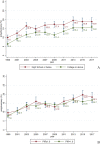Prevalence and trends of polypharmacy in U.S. adults, 1999-2018
- PMID: 37434230
- PMCID: PMC10337167
- DOI: 10.1186/s41256-023-00311-4
Prevalence and trends of polypharmacy in U.S. adults, 1999-2018
Abstract
Background: Polypharmacy is one of the most important health issues for its potential impacts on disease burden and healthcare costs. The aim of this study was to update a comprehensive picture of prevalence and trends in polypharmacy over 20 years in U.S. adults.
Methods: Participants included 55,081 adults aged ≥ 20 from the National Health and Nutrition Examination Survey, January 1, 1999, through December 31, 2018. The simultaneously use of ≥ 5 drugs in one individual was defined as polypharmacy. National prevalence and trends in polypharmacy were evaluated among U.S. adults within different demo-socioeconomic status and pre-existing diseases.
Results: From 1999-2000 to 2017-2018, the overall percentages of adults with polypharmacy remained on the rise, increasing from 8.2% (7.2-9.2%) to 17.1% (15.7-18.5%) (average annual percentage change [AAPC] = 2.9%, P = .001). The polypharmacy prevalence was considerably higher in the elderly (from 23.5% to 44.1%), in adults with heart disease (from 40.6% to 61.7%), and in adults with diabetes (from 36.3% to 57.7%). Also, we observed a greater increase rate of polypharmacy in men (AAPC = 4.1%, P < .001), in the Mexican American (AAPC = 6.3%, P < .001), and in the non-Hispanic Black (AAPC = 4.4%, P < .001).
Conclusions: From 1999-2000 to 2017-2018, the prevalence of polypharmacy is continually increasing in U.S. adults. The polypharmacy was especially higher in the older, in patients with heart disease, or diabetes. The high prevalence urges the healthcare providers and health policymakers to manage polypharmacy among specific population groups.
Keywords: Medication; NHANES; National Health and Nutrition Examination Survey; Polypharmacy; Prevalence; Trends.
© 2023. The Author(s).
Conflict of interest statement
No potential conflicts of interest relevant to this article were reported.
Figures




References
Publication types
MeSH terms
LinkOut - more resources
Full Text Sources

